On the afternoon of July 16th the BBC News website published yet another report by the corporation’s ‘special correspondent’ Fergal Keane, once again citing “additional reporting by Haneen Abdeen and Alice Doyard”.
The original version of that report was titled “The lonely death of Gaza man with Down’s syndrome” and like so many of the reports produced by Keane, Abdeen and Doyard since October 2023, it includes a trigger warning.

The following day, the BBC put out a Tweet stating that the title of that report had been changed for reasons not entirely made clear.
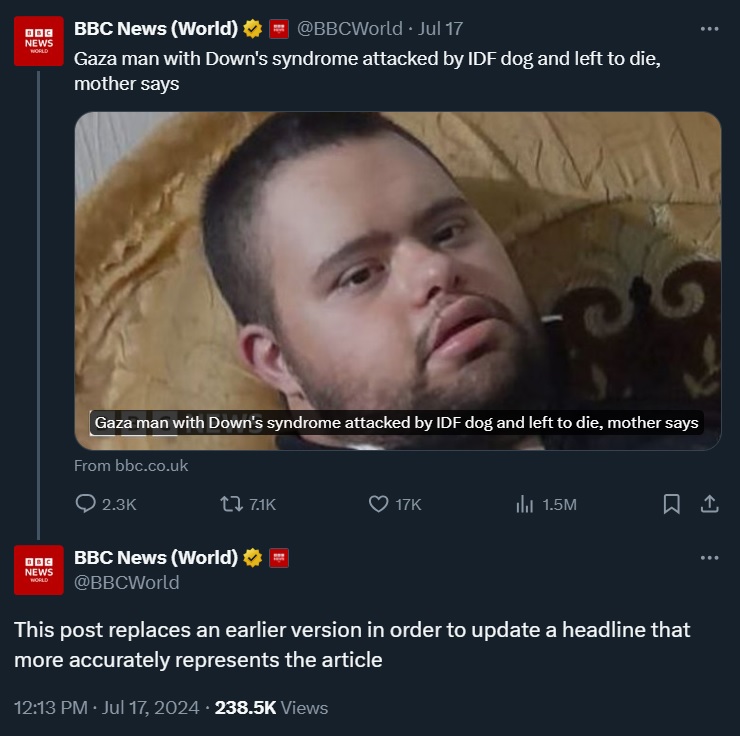
The version of the article currently appearing online carries that amended headline:

As suggested by that headline, Keane’s story is based on accounts provided by the family of the “Gaza man with Down’s syndrome”. The report states that the family did not heed the June 27th instructions from the IDF to evacuate the Shuja’iya neighbourhood.
“On 27 June the war came back to the Bhar family’s neighbourhood and Muhammed’s small world shrank further. Along with other residents of Shejaiya, east of Gaza City centre, the Bhars were given orders to evacuate by the Israel Defense Forces (IDF).
The IDF was advancing into Shejaiya in pursuit of Hamas fighters fighting from tunnels and houses. But the Bhars were tired of moving.”
Readers are told that:
“The fighting intensified in the streets around them. They would hide in different parts of the house, often in the bathroom when shooting became especially intense.
“We were under siege for seven days. The tanks and soldiers were all around the house… Muhammed was staying on his sofa…and he didn’t like sitting anywhere except for there,” says Nabila.”
Keane’s report goes on:
“On 3 July, according to the family, the IDF raided their home on Nazaz Street. Nabila says there were several dozen soldiers with a combat dog – animals used to find Hamas fighters, and check for booby traps and explosives.”
Notably, readers are not told why “the IDF raided” that specific house or whether or not there is any connection to the following statements appearing later in Keane’s article:
“Two of his brothers were arrested by the army. They have still not been released.”
According to the account given by the family, Muhammed Bhar was bitten by the combat dog.
“Around this point, says Nabila, the soldiers took the young man into another room, and away from the dog. They tried to treat his wounds.
A terrified Muhammed, who had always depended on his family for help, was now in the care of combat soldiers, who had come from streets where they’d been fighting close quarter battles with Hamas.
“They took him away, put him in a separate room, and locked the door. We wanted to see what happened to him. We wanted to see Muhammed, to see what had become of him,” says Nabila.
“They told us to be quiet and aimed their guns at us. They put us in a room by ourselves, and Muhammed was alone in another room. They said, ‘We will bring a military doctor to treat him.’” At one point, according to Nabila, a military doctor arrived and went into the room where Muhammed was lying.”
The report goes on to state that “the family was ordered at gunpoint to leave, leaving Muhammed behind with the soldiers” and that a week later, one of his brothers returned to the house and found Muhammed’s body. Despite having inferred otherwise in his report’s headline, Keane tells readers that: [emphasis added]
“It is not clear what exact injury caused Muhammed’s death. Nor what happened to him in the time his family last saw him, and when his brother returned and filmed the dead young man on the floor.”
The original version of Keane’s report stated:
“The family is demanding an investigation but with fighting still going on, and so many dead, it is hard to be hopeful that will happen any time soon. In response to queries from the BBC the IDF said they were checking on the report.”
Notably, the BBC chose not to wait for the IDF’s reply to its queries about an incident two weeks earlier and instead went ahead and published Keane’s report without the IDF’s full response.
Three days after Keane’s report originally appeared, a footnote was added:
![]()
The parts added to the article read as follows:
“The Israeli military has admitted that a Palestinian man with Down’s syndrome who was attacked by an army dog in Gaza was left on his own by soldiers, after his family had been ordered to leave.
Mohammed Bhar was found dead by his family a week later. Responding to queries from the BBC, the Israeli army said the troops left Muhammed Bhar alone because soldiers injured in a rocket attack needed their help. […]
The Israeli military confirmed to the BBC that an army dog attacked Mr Bhar and that after giving him initial medical treatment the soldiers left him on his own. According to the IDF, troops entered the house during intense combat as “part of an operation against the terrorists.”
During the search of the building the dog “bit an individual.” He was given treatment, and the family was “urged to evacuate the apartment to avoid staying in the combat area.”
The army said the troops then left Mr Bhar alone because soldiers injured in an RPG (Rocket Propelled Grenade ) elsewhere needed help. One of those soldiers died.
Saying that the “IDF regrets any harm to civilians during combat” the statement accused Hamas of using civilians as human shields. The statement does not address Mr Bhar’s condition when the soldiers left him.”
Members of the BBC’s audience who had read Keane’s report anytime during the previous three days since its publication would of course be highly unlikely to revisit it on the off chance that it had been amended to include the IDF’s response.
CAMERA UK also approached the IDF Spokesperson. We were informed that the investigation into the incident had taken some time. The full response we – and the BBC – received on July 19th reads as follows: [emphasis added]
“On the day of the incident, intensive operational activity took place in the combat zone, involving significant exchanges of fire between IDF troops and Hamas terrorists. As part of the operation against the terrorists, the troops searched buildings using a canine. Inside one of the buildings, the canine detected terrorists and bit an individual. The troops provided initial medical treatment to that individual in a separate room within the building and urged its family to evacuate the apartment to avoid staying in the combat area.
Exchanges of fire continued throughout the operation, during which an RPG was fired at our troops, hitting an IDF tank and causing injuries to soldiers, ultimately resulting in the death of one of them. Following the RPG strike, the troops that gave initial medical treatment to the individual who was bitten in the apartment, had to leave to ensure treatment was given to the injured soldiers. At this point the individual likely remained alone in the building.
The canines used by the IDF are highly trained and operate to the highest standards. Their contribution to the war effort is significant, often saving the lives of IDF soldiers in dangerous situations in the fight against the Hamas terrorist organisation. Several canines have even sacrificed their lives during combat.
It should be emphasised that this incident underscores Hamas’s practice of operating within civilian environments and using the civilian population as human shields.
The IDF regrets any harm to civilians during combat operations.”
The officer killed by the RPG strike was named as Captain Elay Elisha Lugasi, 21, a team commander in the 7th Armoured Brigade’s 75th Battalion, from Kiryat Shmona. Three more soldiers from the same battalion were seriously wounded in the same incident.
As we see, the BBC’s paraphrased account of the IDF’s response omits any mention of the terrorists detected in the building in which the story recounted by Keane took place.
As is the case in so many BBC reports – including those produced by Keane, Doyard and Abdeen – readers are not provided with any information concerning the source of this story from the Gaza Strip.
With foreign journalists currently unable to enter the Gaza Strip and local BBC journalists who were based there having mostly left the territory several months ago, as the BBC itself has stated, it now relies on “freelancers inside Gaza who liaise with a talented young Palestinian producer in our office in Jerusalem”. As we also know, the BBC refrains from identifying those freelancers, even when it bases stories on their reporting or filming.
On July 12th – four days before the publication of this latest report by Keane – the Qatar-linked media outlet ‘Middle East Eye’ published a report with a title bearing remarkable resemblance to the amended headline of Keane’s article.

In addition to being a self-described “human rights activist and journalist”, the writer of that ‘Middle East Eye’ report, Maha Hussaini, is also the ‘strategy director’ and a member of the board of directors at the Hamas-linked NGO ‘Euro-Med Human Rights Monitor’.
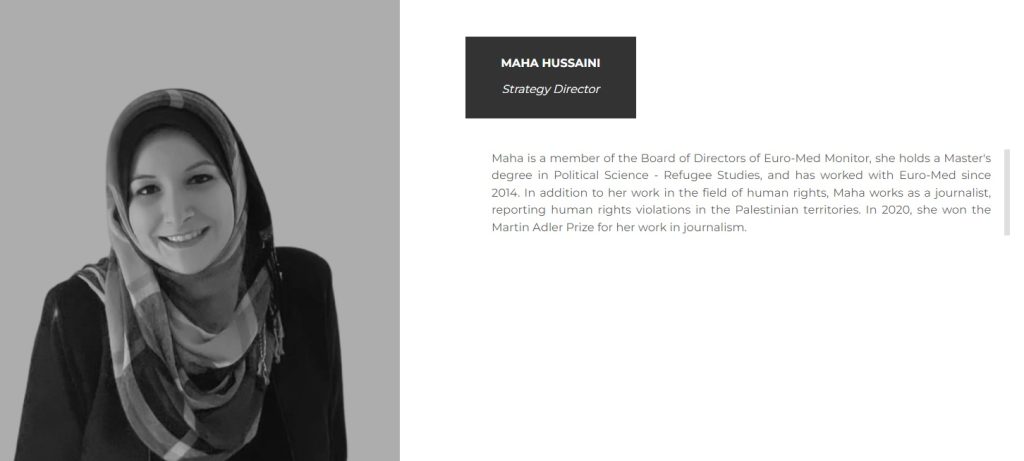
In June of this year, the International Women’s Media Foundation revoked an award it had planned to give to Hussaini after evidence emerged of her having supported Hamas’ October 7th massacre and previous antisemitic social media posts. In January 2024, Hussaini posted the following:
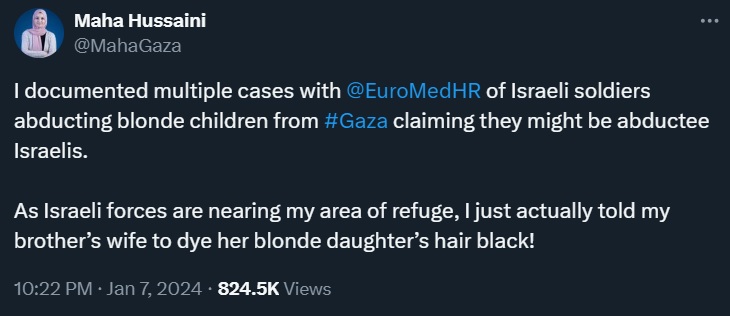
As previously documented here, between October 31st and November 11th, the BBC News website published three English language items featuring the ‘outreach and advocacy officer’ at ‘Euro-Med Human Rights Monitor’, including one by Fergal Keane:
BBC JOURNALISTS CONTINUE TO IGNORE IMPARTIALITY AND SOCIAL MEDIA GUIDELINES
Another employee of that Hamas-linked NGO was quoted in a BBC News website report published in early December:
BACKGROUND TO A ‘HUMAN RIGHTS’ NGO WITH EMPLOYEES RECENTLY FEATURED IN BBC CONTENT
In May 2024, a BBC News website report quoted a Gaza Strip-based journalist who works for the the ‘We Are Not Numbers’ project run by that same NGO:
BEHIND THE BBC’S “PALESTINIAN JOURNALIST” LABEL
Did Fergal Keane and his team get this story from the ‘Middle East Eye’ contributor Maha Husseini who, according to one of her colleagues was “the first journalist to break this horrible story” and whose own article is illustrated with the same main photograph as that appearing in the BBC’s report? Given the lack of transparency on the BBC’s part regarding the sources of stories it publishes about the Gaza Strip and its insistence on not identifying the ‘freelancers’ presumably paid with licence fee funding, it is of course impossible to say.
What we do know based on the BBC’s past record is that despite the fact that Hamas is a proscribed organisation in the UK, the corporation has in the past used contributions from employees of the clearly partial and politically motivated Hamas-linked NGO ‘Euro-Med Human Rights Monitor’ which was founded and is headed by a person who publicly lauded Hamas’ October 7th atrocities.
An alternative explanation is of course that Keane and his team are simply of the opinion that content put out by a partisan, Muslim Brotherhood supporting media outlet with ties to the regime which hosts and has funded the Hamas terrorist organisation is worth copying – despite their inability to fact check and verify such content.
Related Articles:
OMISSIONS IN BBC REPORTS ON FIGHTING IN SHUJA’IYA
MORE UNCRITICAL BBC PROMOTION OF CLAIMS FROM HAMAS-RUN CIVIL DEFENCE
BBC MEDIA EDITOR’S SOFTBALL INTERVIEW WITH FELLOW JOURNALIST SOLD AUDIENCES SHORT
BBC NEWS STICKS TO THE NARRATIVE IN REPORTS ON UNRWA SCHOOLS

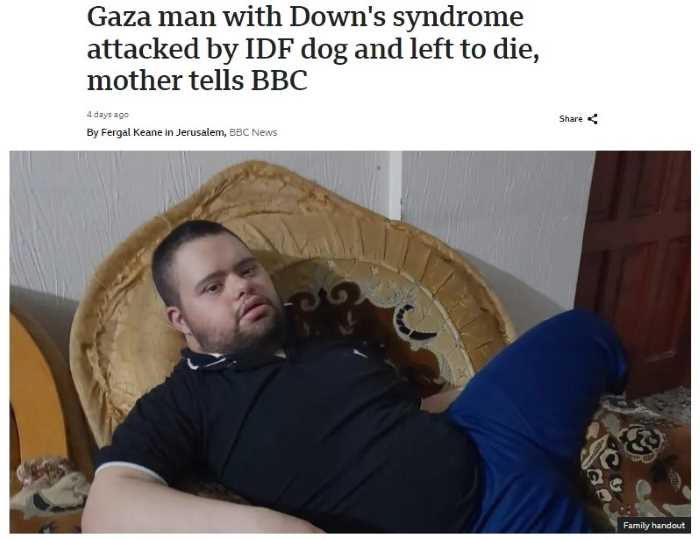
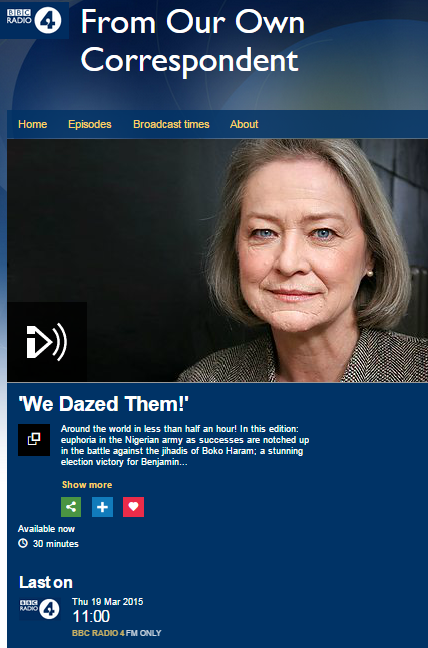

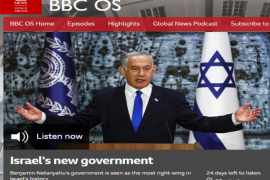
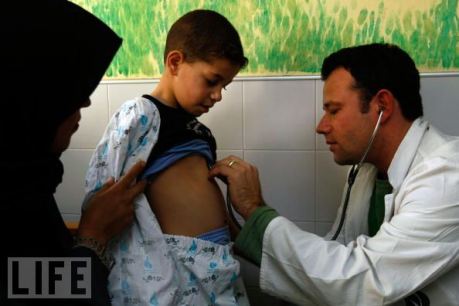
The IPC (aka BBC) should be sanctioned and prosecuted for its blatant support of a proscribed terrorist organisation.